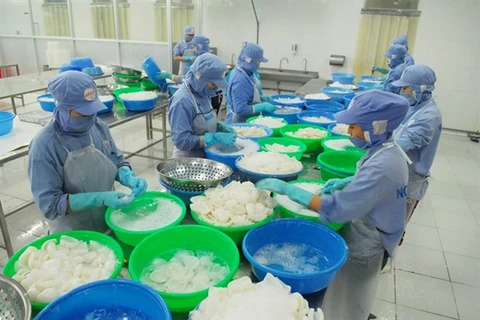Hanoi (VNA) – Aquatic exports are likely to increase 5 percent from last year to 7.4 billion USD in 2017, despite difficulties in overseas markets and fiercer competition, the Vietnam Association of Seafood Exporters and Producers (VASEP) said.
It forecasts growth in shipments to the US, the EU and Japan – the three biggest markets. While the shipments of aquatic products to the US could expand 5 percent to 1.5 billion USD, those to the EU and Japan are likely to rise only 1 percent and 2 percent to some 1.2 billion USD and 1.1 billion USD, respectively.
At a meeting in Ho Chi Minh City on January 19, VASEP Chairman Ngo Van Ich said although aquatic exports encountered problems in the first three months of 2016, they started to rebound in the Q2 and grew for the rest of the year, reaching more than 7.05 billion USD for 2016.
Revenue rose by 7.4 percent from the previous year and contributed some 22 percent to total agro-forestry-fishery exports.
Vietnam shipped aquatic products to 161 markets in 2016 with 3.13 billion USD worth of shrimp and 1.67 billion USD worth of tra fish, both of which went up about 7 percent.
Deputy Minister of Agriculture and Rural Development Vu Van Tam described last year’s aquatic exports as impressive as the agricultural sector contracted in the first half of the year, and few believed shrimp export volume would reach 652,000 tonnes since only 190,000 tonnes were exported in the first six months of 2016.
He said facing an unfavourable situation, many seafood processors and exporters shifted to environmentally friendly development models instead of racing to export as much as they could.
While the quality of aquatic products improved last year, marine pollution along the central coast in early 2016 affected the prestige of Vietnamese seafood. Some countries enhanced examinations of fisheries products from Vietnam, said Nguyen Nhu Tiep – Director of the agriculture ministry’s National Agro-Forestry-Fisheries Quality Assurance Department.
VASEP Secretary General Truong Dinh Hoe said saltwater intrusion, high production cost of raw materials, strong competition and technical barriers in import markets will remain challenges for seafood businesses.
Agreeing, Tam warned of an emerging challenge with some countries protecting local production through technical barriers or food safety and quarantine regulations to hamper imports.
Businesses should keep updated on export markets to avoid having their goods returned, he said.
At the meeting, enterprises also asked the Government for support policies to ensure the domestic supply of raw materials, improve farming-processing-export links, and reduce production costs.-VNA
VNA

























